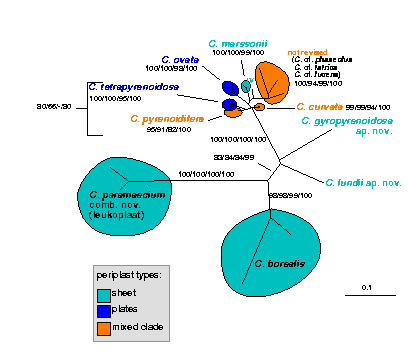Molecular Phylogeny and Systematics of the Cryptophyceae
Cryptophyceae are unicellular algae, that are not related to plants. Although they may become quite abundant in freshwater and marine habitats, thus play important roles in aqueous ecosystems, their systematics is questionable (Pedrós-Alió et al. 1987; Buma et al. 1992; Pinckney et al. 1998 and others). |
|
Former species descriptions were based predominantly on light microscopical characters (Skuja 1939, 1948 and many others). Electron microscopy unveiled delicate structures of the cell surroundings and other morphological differences that were used to distinguish among genera (reviewed by Clay and Kugrens 1999). This, however, invalidated the old light microscopical species descriptions.
Molecular phylogenetic analyses in combination with an examination of morphology showed that neither most light microscopically visible characters nor the ultrastructural characters found by electron microscopical means result in a reasonable systematics that reflects the natural relationships among the cryptophytes (Hoef-Emden et al. 2002; Hoef-Emden and Melkonian 2003; Hoef-Emden 2005). Light microscopical characters were either unreliable or unspecific, and in the genera Proteomonas and Cryptomonas, ultrastructural characters were shown to be correlated with a not yet understood dimorphic life history (Hill and Wetherbee 1986; Hoef-Emden and Melkonian 2003). Cryptophyte systematics is in a state of mess. The genus concept is questionable due to dimorphism, also it is almost impossible to determine species solely on morphological characters.
By combining molecular phylogenetic analyses with morphology and by establishing molecular markers to distinguish among cryptophyte genera and species hopefully a sound and extendable systematic basis for future research can be established.
The Fig. at the top shows a differential interference contrast photomicrograph of a Rhodomonas cell.
A more detailed introduction to the cryptophytes can be found here.
References
- Buma AGJ, Gieskes WWC, Thomsen HA (1992). Abundance of Cryptophyceae and chlorophyll b-containing organisms in the Weddell-Scotia Confluence area in the spring of 1988. Polar Biol 12: 43-52
- Clay BL, Kugrens P (1999). A revised classification of the Cryptophyta. Bot J Linn Soc 131: 315-328
- Hill DRA, Whetherbee R (1986). Proteomonas sulcata gen. et sp. nov. (Cryptophyceae), a crypomonad with two morphologically distinct and alternating forms. Phycologia 25: 455-463
- Hoef-Emden K (2005). Multiple independent losses of photosynthesis in the genus Cryptomonas (Cryptophyceae) - combined phylogenetic analyses of DNA sequences of the nuclear and the nucleomorph ribosomal operons. J Mol Evol 60: 183-195
- Hoef-Emden K Melkonian M (2003). Revision of the genus Cryptomonas: a combination of molecular phylogeny and morphology provides insights into a long-hidden dimorphism. Protist 154: 359-397
- Hoef-Emden K, Marin B, Melkonian M (2002). Nuclear and nucleomorph SSU rDNA-phylogeny in the Cryptophyta and the evolution of cryptophyte diversity. J Mol Evol 55: 161-179
- Pedrós-Alió C, Gasol JM, Guerrero R (1987). On the ecology of a Cryptomonas phaseolus population forming a metalimnic bloom in Lake Cisó, Spain – annual distribution and loss. Limnol Oceanogr 32: 285-298
- Pinckney JL, Paerl HW, Harrington MB, Howe KE (1998). Annual cycles of phytoplankton community-structure and bloom dynamics in the Neuse River Estuary, North Carolina. Mar Biol 131: 371-381
- Skuja H (1939). Beitrag zur Algenflora Lettlands II. Acta Horti Bot Univ Latviensis 11/12: 41-169
- Skuja H (1948). Taxonomie des Phytoplanktons einiger Seen in Uppland, Schweden. Symb Bot Ups IX: 346-367

The figure shows a nucleomorph SSU rDNA phylogeny of the genus Cryptomonas (unrooted maximum likelihood tree; evolutionary model: TVM+I+G; support values: distance /parsimony /ML bootstrap/posterior probability; scale bar: substitutions per site)
Contact: Kerstin Hoef-Emden
|